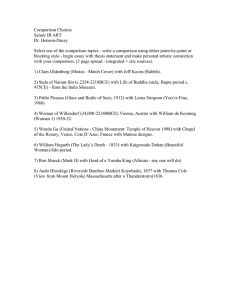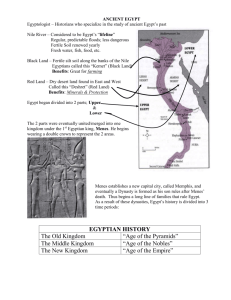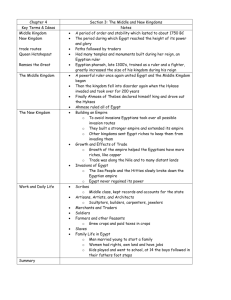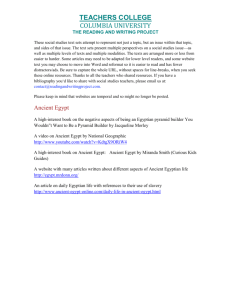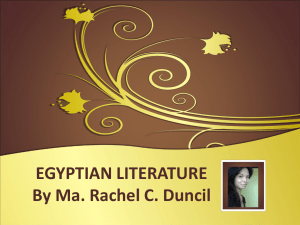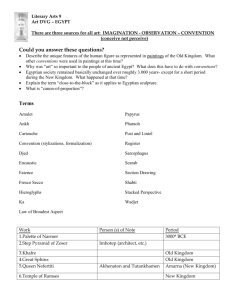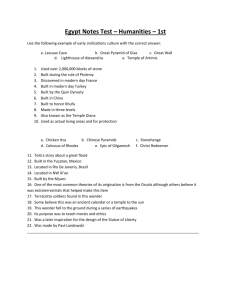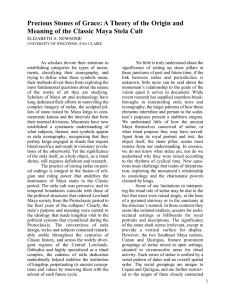HUMANITIES 2 - David Miano
advertisement
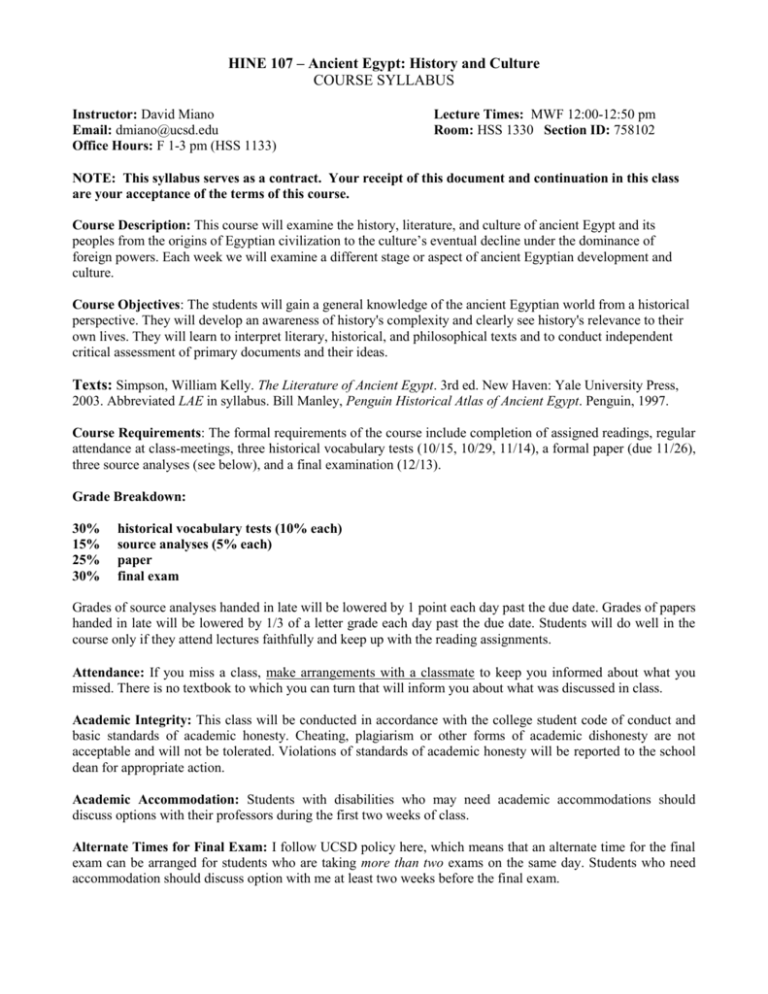
HINE 107 – Ancient Egypt: History and Culture COURSE SYLLABUS Instructor: David Miano Email: dmiano@ucsd.edu Office Hours: F 1-3 pm (HSS 1133) Lecture Times: MWF 12:00-12:50 pm Room: HSS 1330 Section ID: 758102 NOTE: This syllabus serves as a contract. Your receipt of this document and continuation in this class are your acceptance of the terms of this course. Course Description: This course will examine the history, literature, and culture of ancient Egypt and its peoples from the origins of Egyptian civilization to the culture’s eventual decline under the dominance of foreign powers. Each week we will examine a different stage or aspect of ancient Egyptian development and culture. Course Objectives: The students will gain a general knowledge of the ancient Egyptian world from a historical perspective. They will develop an awareness of history's complexity and clearly see history's relevance to their own lives. They will learn to interpret literary, historical, and philosophical texts and to conduct independent critical assessment of primary documents and their ideas. Texts: Simpson, William Kelly. The Literature of Ancient Egypt. 3rd ed. New Haven: Yale University Press, 2003. Abbreviated LAE in syllabus. Bill Manley, Penguin Historical Atlas of Ancient Egypt. Penguin, 1997. Course Requirements: The formal requirements of the course include completion of assigned readings, regular attendance at class-meetings, three historical vocabulary tests (10/15, 10/29, 11/14), a formal paper (due 11/26), three source analyses (see below), and a final examination (12/13). Grade Breakdown: 30% 15% 25% 30% historical vocabulary tests (10% each) source analyses (5% each) paper final exam Grades of source analyses handed in late will be lowered by 1 point each day past the due date. Grades of papers handed in late will be lowered by 1/3 of a letter grade each day past the due date. Students will do well in the course only if they attend lectures faithfully and keep up with the reading assignments. Attendance: If you miss a class, make arrangements with a classmate to keep you informed about what you missed. There is no textbook to which you can turn that will inform you about what was discussed in class. Academic Integrity: This class will be conducted in accordance with the college student code of conduct and basic standards of academic honesty. Cheating, plagiarism or other forms of academic dishonesty are not acceptable and will not be tolerated. Violations of standards of academic honesty will be reported to the school dean for appropriate action. Academic Accommodation: Students with disabilities who may need academic accommodations should discuss options with their professors during the first two weeks of class. Alternate Times for Final Exam: I follow UCSD policy here, which means that an alternate time for the final exam can be arranged for students who are taking more than two exams on the same day. Students who need accommodation should discuss option with me at least two weeks before the final exam. Lecture and Reading Schedule This list is a basic outline for this semester and is subject to change depending on the needs of the class. Any changes to lectures, assignments, or exams will be announced in class. It is the student’s responsibility to stay informed of any changes. Readings and lectures are grouped according to week. Week 0: Emergence of the Egyptian State (9/28) Reading Assignment: none Week 1: The Early Dynastic Period and Old Kingdom (10/1, 10/3, 10/5) Reading Assignment: LAE, “Old Kingdom” (see below) Week 2: The Old Kingdom and First Intermediate Period (10/8, 10/10, 10/12) Reading Assignment: LAE, “First Intermediate Period” (see below) Week 3: The Middle Kingdom (10/15, 10/17, 10/19) Reading Assignment: LAE, “Middle Kingdom” (see below) Week 4: The Middle Kingdom and Second Intermediate Period (10/22, 10/24, 10/26) Reading Assignment: LAE, “Second Intermediate Period” (see below) Week 5: The New Kingdom (10/29, 10/31, 11/2) Reading Assignment: LAE, “New Kingdom” (see below) Week 6: The New Kingdom and Third Intermediate Period (11/5, 11/7, 11/9) Reading Assignment: LAE, “Third Intermediate Period” (see below) Week 7: The Late Kingdom (11/14, 11/16) Reading Assignment: none Week 8: Egypt under Persian Rule (11/19, 11/21) Reading Assignment: LAE, “Egypt under Persian Rule” (see below) Week 9: Egypt of the Ptolemies (11/26, 11/28, 11/30) Reading Assignment: LAE, “Egypt of the Ptolemies” (see below) Week 10: Egypt of the Ptolemies (12/3, 12/5, 12/7) Reading Assignment: none Final Examination: 12/13 (11:30 am-2:30 pm) LAE texts according to chronology. Old Kingdom The Maxims of Ptahhotep (129-148) The Instructions of Hardedef (127-128) The Teaching for the Vizier Kagemni (149-151) Selections from the Pyramid Texts (247-262) Old Kingdom Autobiographies (401-413) First Intermediate Period The Admonitions of an Egyptian Sage (188-210) The Teachings for King Merikare (152-65) The Stela of Tjetji (414-17) Middle Kingdom Middle Egyptian Literature (11-53) The Story of Sinuhe (54-66) The Teaching of King Amenemhet I for his Son Senwosret (166-71) The Prophecies of Neferty (214-220) Amenemhet and Khnumhotep II at Beni Hasan (418-24) Coffin Texts (263-266) Cycle of Songs in Honor of Senwosret III (301-306) The Semna Stela (337-38) The Stela of Iykhernofret (425-27) The Loyalist Instruction from the Sehetepibre Stela (172-74) The Instruction of a Man for His Son (175-77) The Man Who Was Weary of Life (178-187) The Lamentations of Khakheperre-Sonbe (211-213) The Satire on the Trades (431-437) Second Intermediate Period The Neferhotep Stela (339-344) Quarrel of Apophis and Seknenre (69-71) The Kamose Texts (345-350) New Kingdom The Poetical Stela of Thutmose III (351-355) The Capture of Joppa (72-74) The Instruction of Amunnakhte (221-222) The Instruction of Amenemope (223-243) The Hymn to the Aten (278-283) The Love Songs and the Song of the Harper (307-333) The Tale of the Doomed Prince (75-79) The Tale of Two Brothers (80-90) A Ghost Story (112-115) The Israel Stela (356-360) The Contendings of Horus and Seth (91-103) The Blinding of Truth by Falsehood (104-107) The Scribal Traditions in the Schools (438-441) The Third Intermediate Period The Report of Wenamon (116-124) The Victory Stela of Piye (367-85) Egypt under Persian Rule The Bentresh Stela (361-366) Egypt of the Ptolemies The Satrap Stela (392-97) The Tale of Amasis and the Skipper (450-452) The Romance of Setna Khaemuas and the Mummies (453-469) The Famine Stela (386-391) The Prophecy of the Lamb (445-449) The Instruction of ‘Onchsheshonqy (497-529) The Adventures of Setna and Si-Osire (470-489) The Childhood of Si-Osire (490-491) The Magician Hihor (492-493) The Fable of the Swallow and the Sea (494-496) Source Analysis Assignment #1 Questions on the Readings: 1. In the four Instructions in Wisdom (Ptahhotep, Hardedef, Kagemni, and Merikare), what major values are implied: social, religious, political? According to them, what is a human’s relationship to the gods? 2. In the Pyramid Texts, what vision of the afterlife is revealed? Give your interpretation of the passages that you think are significant. 3. What virtues do Weni, Harkhuf, and Tjetji boast about in their autobiographies? Fully answer the questions (at least a paragraph for each number). Do not consult outside sources to get your answers. Provide your own interpretations. Due Wednesday, 10/12. Source Analysis Assignment #2 Questions on the Readings: 1. King Cheops and the Magicians (Third Tale). What is it that is so admirable about Djadjaemonkh in the eyes of the author? 2. Tale of the Eloquent Peasant. What does the story reveal about how the justice system worked in Middle Kingdom Egypt? How does the peasant use the concept of ma’at to convince Rensi to help him? What does the story reveal about how rhetoric functioned in the Middle Kingdom? 3. The Shipwrecked Sailor. What is the moral of the story? Is the sailor wise or a fool? Is the snake a symbol of something or is it just a snake? 4. The Story of Sinuhe. What are the circumstances of Sinuhe’s flight? What is the essential cause of his flight? What does he do or not do that is wrong, and what does the king think of it. What specifically does Sinuhe want from the king, and does he get it? 5. Coffin Texts (Spell 148): What do you learn about the Osiris-Isis-Horus myth from this text? 6. The Loyalist Instruction from the Sehetepibre Stela: What reasons are given for why the king is worthy of obedience? 7. Lamentations of Khakheperre-Sonbe: What does the author desire? Why do you think this is important to him? 8. In the Kamose Texts, what is the nature of the disagreement between Kamose and his advisors? What drives Kamose? Fully answer the questions (at least a paragraph for each number). Do not consult outside sources to get your answers. Provide your own interpretations. Due Wednesday, 10/26. Source Analysis Assignment #3 Questions on the Readings: 1. List some basic principles of morality you find appearing frequently throughout The Instruction of Amenemope. 2. How is justice achieved in The Tale of the Two Brothers and The Blinding of Truth by Falsehood? What similarities do you see between the two stories? 3. After reading the Love Songs (pp. 308-331), make some observations about the similarities between romance in ancient Egypt and today. 4. What principles does Piye encourage his troops to follow in The Victory Stela of Piye? 5. What do you think is the moral of The Romance of Setna Khaemuas and the Mummies? 6. The Instructions of ‘Onchsheshonqy. How does Harsiese come to be the Pharaoh’s chief physician?. How does Onchsheshonqy get a position at court? What disagreement do Harsiese and Onchsheshonqy have? How does the Pharaoh punish the conspirators? In the context of the narrative, what is the purpose of Onchsheshonqy’s “Instructions”? How do Harsiese, Onchsheshonqy, and the Pharaoh perceive the god Pre to be operating in their life situations? Fully answer the questions (at least a paragraph for each number). Do not consult outside sources to get your answers. Provide your own interpretations. Due Monday, 11/30. Paper Assignment You are to write a paper examining one aspect of Egyptian culture. You will choose from the following: 1) government; 2) military and warfare; 3) social relationships; 4) ethics; 5) education; 6) jobs; 7) religious beliefs; 8) medicine. All of the points you wish to establish must be drawn from the Egyptian texts in W. K. Simpson, The Literature of Ancient Egypt. A. Sources: 1. Use only the primary texts from the book as sources. No bibliography needed. No secondary sources are to be used (in other words, concentrate on the content of the literature itself, rather than on historical background). Do not cite lecture. Do not quote or cite the translator’s introductions. Draw all arguments from the texts. 2. The more sources discussed, the better. A minimum of three is required. 3. When you make an assertion essential to your case, you must provide textual references as evidence. Quote the text to prove important points, or when it is necessary for your audience to see the words. To make lesser points, a citation is sufficient. 4. Cite primary sources within the text itself—no footnotes necessary. 5. Note that the views of the authors may be expressed either directly or through stories. When analyzing the stories, always look for the message that is trying to be conveyed. What is the moral? 6. Note that you are not being asked to discuss other people’s interpretations of the texts. We want your interpretations only. 7. Explain how you know what the text means. Show your reasoning. 8. Do not judge the value of the assertions made in the texts. In other words, do not tell us whether you think the authors’ views are right or wrong, good or bad. Just tell us what you think the authors’ views are. 9. Copying anything from the internet or another source and presenting it as your own work is plagiarism and will result in an automatic F. B. Structure: 1. State your argument concisely and as early as possible in your paper (first paragraph). Your argument (thesis) is simply your conclusion stated up front. Say what you came up with, and then you can show how you got there. 2. Do not stray from your thesis anywhere in your essay, so your argument is not submerged in meaningless detail. 3. Write in coherent paragraphs. Each one should have a single controlling idea or point to make. 4. Organize your paper effectively. It is much better to organize it by topic than to simply discuss each text in order. 5. Keep sentences short enough to be manageable. 6. Write about the past in the past tense. Write about literature in the present tense (i.e., “The author writes…,” “Sinuhe says...”). C. Format: 1. Type essays, double-spaced, 12-point. 2. Page requirement: 5 minimum, 6 maximum. 3. Staple the pages together. 4. Have a title, but no title page is needed (or desired). Center your title and put your name underneath it. 5. Number all pages (except the first). DATE DUE: Anytime up until 11/26.
